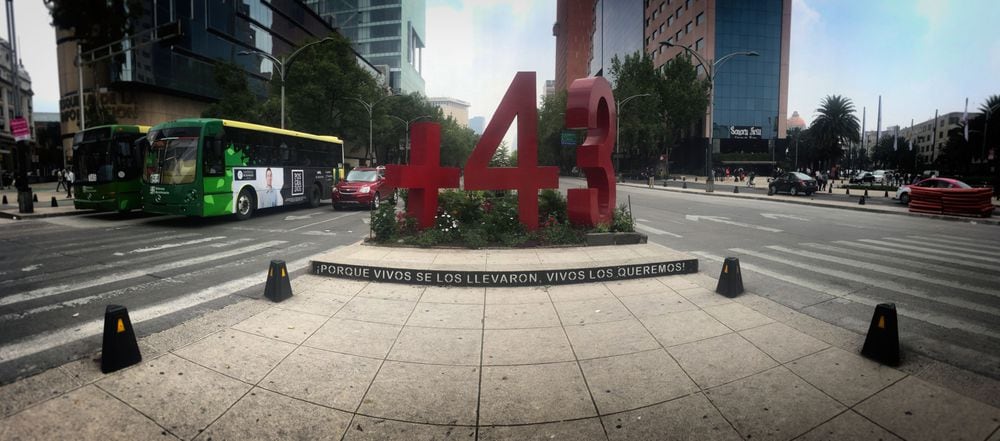The recent history of Mexico accumulates ignominies that the people refuse to forget.
Terror without justice and burning disappearances in memory.
David and Miguel were kidnapped in 2012 and it was never known again;
49 children died in the fire of a nursery school in Sonora in 2009 without clarification of responsibilities;
10 years ago, dozens of men were trapped in the Pasta de Conchos mine;
Today is the sixth anniversary of the disappearance of the Iguala students, the notorious 43 from Ayotzinapa, whose bodies are being searched for an imprecise geography.
Those affected have decided to keep all these causes alive by occupying a public space that also belongs to them: Paseo de la Reforma, the most emblematic and bustling boulevard in the Mexican capital, has become in recent years a collective expression of memory.
Overnight, where there was a bush, a monument is erected that reminds the public authorities that there are people who wait for legitimate reparation.
On August 22, in broad daylight and without municipal permits, the last of these anti-monuments, as they have come to call them, was erected in memory of the 72 migrants from San Fernando (Coahuila), murdered by the Zetas cartel. , an unpunished massacre.
The placement of this symbol and many others that are distributed along the Paseo de la Reforma, the financial artery of the capital, reminds that demolishing statues is not the only way to protest;
so is lifting them.
When the antimonumento to the disappeared normalistas was installed - a huge number 43 accompanied by a cross, all in red iron - brigades were organized so that they would not tear it down and the driver who transported it was arrested.
It was 2015. In 2017 the memory of the 49 children who died in the Sonora fire was forever planted, and in 2018 those who demanded the rescue of David and Miguel and the memory of the miners of Pasta de Conchos.
The movement seems unstoppable and the Government of the capital is delighted with it.
“They deserve our respect and admiration.
These collectives show us with their actions how they reappropriate the most emblematic public space of the city and give us hope of the powerful life that exists in it.
The Paseo de la Reforma was for years a museum space that has now been retaken by its inhabitants to leave an urban imprint on events that should never be repeated.
The city appreciates it ”, says the Secretary of the Government of Mexico City, José Alfonso Suárez del Real.
The official is not afraid that others will come with their creations and end up leaving the boulevard as a flea market.
"Of course there is that possibility, but also the other: in Oaxaca they put some horrendous plastic animals and people took them away."
Beauty, in any case, is not the patrimony of those who rule.
The Paseo de la Reforma is dotted with statues of zero aesthetic value and little instructive power.
Maybe they decorate.
Little bronze soldiers with coat and broadsword, poets in frock coats and religious capisayos.
A space that this year they have wanted to bring into line with the new century by incorporating two female figures, an anonymous sculpture representing the women who fought for independence from Spain and the most notable heroine of them all, Leona Vicario, who had to have her character, however, on her pedestal reads "most sweet mother of the country."
Suárez del Real also welcomes this advance towards equality between men and women: "We have an
anti-monument in
front of the Palacio de Bellas Artes."
Indeed, this same year, on March 8, feminists also raised their symbol and 32 crosses in iron, one for each state, so that no one forgets that 10 women are murdered every day in this country.
"Society makes space alive", adds the Secretary of Government.
“We do not ask permission to put them, this does not come from the Government, rather it is against the Governments, an act of rebellion due to the impunity in which many crimes remain.
But it is true that they have shown sensitivity towards antimonuments.
They are desperate expressions against oblivion, so that they remember the outstanding debts ”, summarizes Ana Lorena Delgadillo, director of the Foundation for Justice and the Democratic State of Law, who participated last month in the placement of the one that stood to remember that "no one is illegal in the world" and that "to migrate is a human right", as read in the symbol of the San Fernando.
Interestingly, these emblems that dot Reforma seem to have come from the same workshop.
These are iron carvings with a large number that signify the victims of each tragedy, sometimes with a cross, sometimes with a "+", because in Mexico violence and tragedies do not seem to have an end.
Or in Delgadillo's words: “Reforma is already the street of serious human rights violations.
I hope it was also that of justice ”.






/cloudfront-eu-central-1.images.arcpublishing.com/prisa/2C5HI6YHNFHDLJSBNWHOIAS2AE.jpeg)



